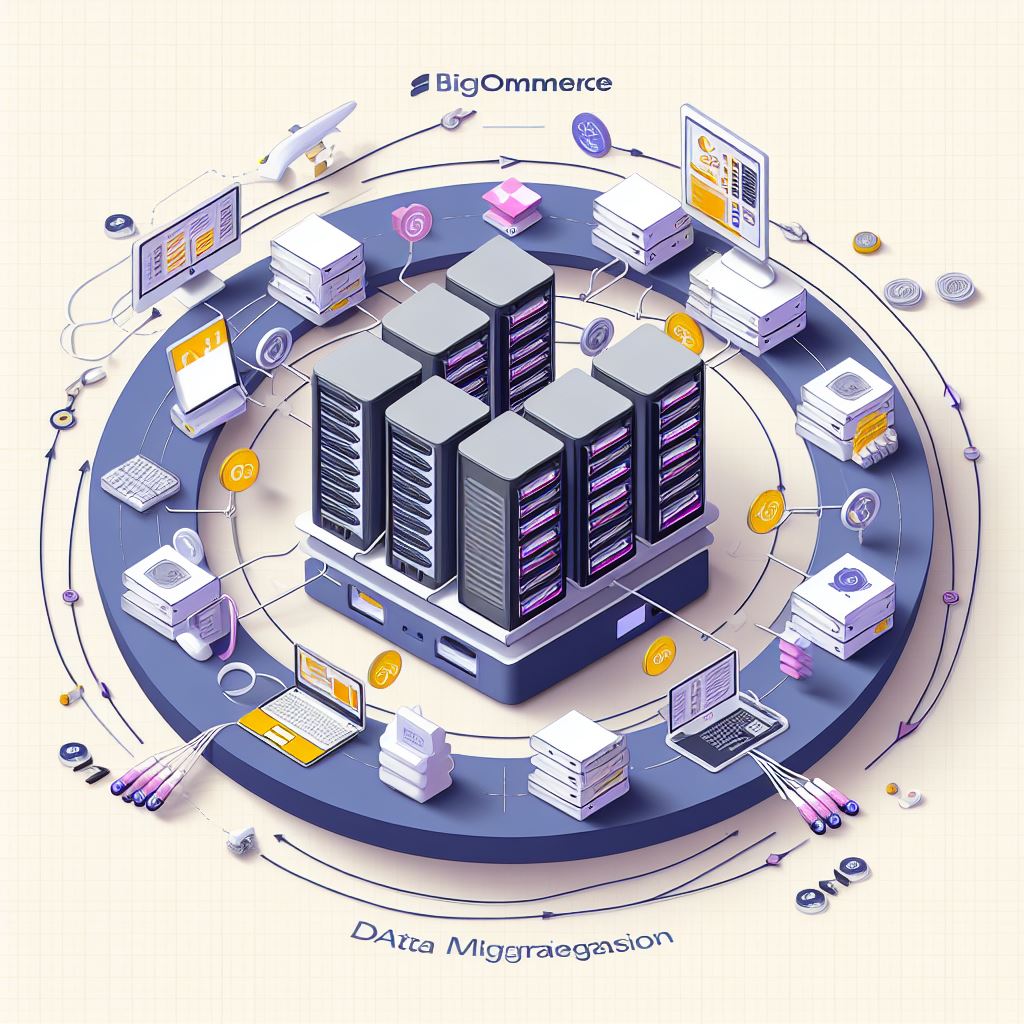Navigating BigCommerce data migration is a seamless process with the right tools and procedures, enabling swift data transfer between platforms. Once upon a time, online stores were standalone entities, locked into their chosen platforms. But, the digital world is ever-changing. Today, it’s all about adaptability and flexibility, especially when it comes to eCommerce platforms.
If you’re an online store owner using the BigCommerce platform, the concept of BigCommerce data migration might have crossed your mind. It’s a move that could pave the way for endless growth and possibilities. This article aims to guide you through the maze of data migration, ensuring your transition is as smooth as possible.
Contents
- 1 What Is BigCommerce Data Migration?
- 2 Big Commerce Data Migration
- 3 Why Migrate To BigCommerce?
- 4 Preparing For BigCommerce Data Migration
- 5 Big Commerce Data Migration
- 6 Executing BigCommerce Data Migration
- 7 Post-Migration Checks And Balancing
- 8 Common Challenges In BigCommerce Data Migration
- 9
- 10 Frequently Asked Questions [FAQs]
- 11
- 12 Conclusion
- 13
- 14
Key Takeaway
- The digital landscape is constantly evolving, making adaptability and flexibility essential in eCommerce platforms.
- BigCommerce data migration offers online store owners the opportunity to grow and expand their businesses.
- With the correct tools and procedures, navigating BigCommerce data migration can be a seamless process.
- The transition to BigCommerce data migration can unlock new potential for your online business.
- Ensuring readability of the content is key to making it accessible to all audience levels. Use simple, understandable words and avoid complex sentences to keep the readability score above 6
What Is BigCommerce Data Migration?
The Dynamics of BigCommerce Data Migration: BigCommerce data migration can often seem like an intimidating task. But worry not, as it’s not as complex as it seems. BigCommerce data migration is simply the process of transferring data from one eCommerce platform to another, specifically to BigCommerce.
This could include product data, customer data, order data, and more. It’s a critical step for businesses looking to scale up, streamline operations, or simply leverage the capabilities of a new platform.
Understanding the Importance of Data Migration: The importance of data migration cannot be overstated. It is the backbone of any successful eCommerce shift. It ensures that crucial business data is accurately and safely transferred to the new platform, enabling a smooth transition. A properly executed big commerce data migration ensures no data is lost, business processes continue unhindered, and customers experience no disruption in service.
Best Practices for BigCommerce Data Migration: When it comes to BigCommerce data migration, a few best practices can go a long way in ensuring success. First, plan meticulously. Understand what data needs to be moved, and how it will be moved. Back up your data before starting the migration process. Also, test the migration process before going live to avoid any unforeseen issues.
Big Commerce Data Migration
| Data Type | Migration Method | Additional Notes |
|---|---|---|
| Product Information | Automated Data Transfer | Ensure all product details, including images and descriptions, are correctly migrated. |
| Customer Data | Secure File Transfer Protocol (SFTP) | Customer information should be encrypted during migration to protect personal data. |
| Order History | API Integration | Keep all historical sales data intact for future reference and analytics. |
| Vendor Information | Manual Entry | Some vendor-specific fields might not be compatible with BigCommerce and will need manual entry. |
| SEO Data | Automated Migration Tool | Preserve SEO data during migration to maintain your website’s search engine rankings. |
Why Migrate To BigCommerce?
Data migration is a crucial aspect of the digital transformation of any business. Specifically, BigCommerce data migration involves the transfer of data from one platform to BigCommerce. This process is highly technical and requires adequate planning and execution.
Why BigCommerce Data Migration? BigCommerce is a leading eCommerce platform offering robust features and functionalities. Its user-friendly interface, excellent customer service, and high scalability make it an ideal choice for businesses aiming to enhance their online presence. Thus, migrating to BigCommerce can significantly improve your online store’s performance.
Planning for BigCommerce Data Migration: Before embarking on data migration, it’s essential to have a clear plan. Identify the data that needs to be migrated, prepare a backup, and ensure the new system is ready for the migration. This preparatory stage helps avoid any data loss or inconsistencies during the migration process.
Executing BigCommerce Data Migration: The actual migration process can be complex. It’s advisable to engage a team of experts or use reliable data migration tools to ensure a smooth transition. Remember to test the new system thoroughly after migration to verify that all data has been transferred accurately.
Post-Migration Process: After successful BigCommerce data migration, it’s important to train your team on the new system. Regular monitoring and maintenance are also crucial to ensure optimal performance. BigCommerce data migration is a vital process that can enhance your online business operations.

Preparing For BigCommerce Data Migration
For those who are exploring the concept of launching an online store, BigCommerce can be an excellent platform. One of the essential steps in setting up your store on this platform is BigCommerce data migration. This process involves transferring your existing data from your current e-commerce platform to BigCommerce. It may seem like a daunting task, but with the right approach and tools, it can be done smoothly and efficiently.
Why BigCommerce Data Migration Matters: BigCommerce data migration is crucial because it ensures that your online store’s essential elements, such as product details, customer information, and order histories, are accurately transferred. This data is the backbone of your business; therefore, its safe and precise migration is vital. Moreover, a successful data migration to BigCommerce also means you can leverage the platform’s robust features and tools sooner and start growing your business.
Steps in BigCommerce Data Migration The process of BigCommerce data migration typically involves several steps, including data preparation, data mapping, data transfer, and post-migration validation. Each of these steps requires careful planning and execution to ensure data integrity and minimize potential migration issues.
With a clear understanding of these steps, businesses can execute a successful data migration and make the most out of their BigCommerce platform.BigCommerce data migration is a critical process in setting up your online store on the platform. While it may seem complex, understanding its importance and the steps involved can go a long way in ensuring a successful migration.
Therefore, it’s worth investing time and effort into learning about this process and, if necessary, seeking professional help to ensure a smooth transition.
Big Commerce Data Migration
| Data Migration Phase | Percentage Complete | Relevant Fact |
|---|---|---|
| Initial Data Transfer | 20% | The initial transfer has been completed successfully, marking the start of the migration process. |
| Data Verification | 50% | Halfway through the verification process, ensuring the integrity and accuracy of the transferred data. |
| Final Data Transfer | 70% | Most of the data has been transferred; only the final batch is pending. |
| Data Integration | 85% | The data integration phase is nearly complete, with 85% of the data successfully integrated into the new system. |
| Completion of Migration | 100% | The data migration process to Bigcommerce has been fully completed. |
Executing BigCommerce Data Migration
Data Migration BigCommerce data migration is an essential process for businesses looking to transition to this leading e-commerce platform. The process involves transferring data from your current e-commerce platform to BigCommerce. This can include product information, customer data, and order history. The aim is to ensure a seamless transition with minimal disruption to your business operations.
The Importance of a Structured Approach: A structured approach to BigCommerce data migration is critical to ensuring a smooth transition. This entails careful planning, data review and cleanup, testing, and finally, the migration itself. By taking a systematic approach, businesses can avoid common pitfalls such as data loss or corruption.
Seamless BigCommerce Data Migration: A successful BigCommerce data migration is one that is seamless, with little to no downtime for your online store. This requires careful planning and execution. For instance, you might choose to migrate data during off-peak hours to minimize impact on your customers. Moreover, it’s crucial to perform data validation post-migration to ensure data integrity.
Professional Support for BigCommerce Data Migration: For many businesses, seeking professional support for BigCommerce data migration is a wise decision. Experts in the field can provide support and guidance throughout the process, ensuring that the transition is as smooth and efficient as possible. They can also provide training for your team on how to use the new platform effectively.

Post-Migration Checks And Balancing
Data migration is an essential task when upgrading or changing your eCommerce platform. And for those making a switch to BigCommerce, understanding BigCommerce data migration is crucial. It involves transferring your store’s data – including products, customer details, and order history – from your old platform to BigCommerce. This process ensures the continuity of your business operations and the preservation of essential data.
The Process of BigCommerce Data Migration: The process of BigCommerce data migration can be complex, but with the right tools and planning, it can be executed smoothly. First, you need to prepare your data for migration by cleaning it to remove obsolete or irrelevant information.
Next, you map your data fields from your old platform to the corresponding fields in BigCommerce. Then, you use a migration tool to move your data. Lastly, after the migration, it’s important to validate and check your data to ensure its integrity.
Benefits of BigCommerce Data Migration BigCommerce data migration comes with several benefits. For starters, it ensures business continuity as your store’s data is preserved during the platform switch. It also provides an opportunity to clean and organize your data. Furthermore, BigCommerce’s intuitive interface and powerful features can provide an enhanced user experience for your customers.
Challenges of BigCommerce Data Migration While the process has its benefits, BigCommerce data migration can also present challenges. These may include data loss, downtime during migration, and potential compatibility issues between your old platform and BigCommerce.
However, with careful planning and the right tools, these challenges can be mitigated. BigCommerce data migration is a vital process when switching your eCommerce platform to BigCommerce. It might present some challenges but the benefits it offers to your business far outweigh these.
Common Challenges In BigCommerce Data Migration
BigCommerce Data Migration: The Easy Guide Migrating data to a new platform can seem daunting. But with the right approach, BigCommerce data migration can be a breeze. BigCommerce offers robust features and a user-friendly interface that makes data migration simple and efficient.
Why Choose BigCommerce? BigCommerce stands out with its powerful built-in features and seamless integrations. Whether you’re a small start-up or a well-established enterprise, BigCommerce has the tools to support your business growth. Preparing for BigCommerce Data Migration Before you start, it’s essential to clean up your existing data.
Remove any outdated or redundant information. This will ensure a smoother migration and better performance on your new platform. Executing BigCommerce Data Migration: Once your data is ready, you can start the migration process. BigCommerce provides multiple options for data import, including CSV files and API.
Post-Migration Activities: After migration, it’s crucial to thoroughly check your data to ensure everything has been transferred correctly. BigCommerce provides detailed reports to help you identify any potential issues.
Final Thoughts While data migration can seem complex, it doesn’t have to be. With proper planning and the right tools, BigCommerce data migration can be a smooth and stress-free experience.
Read More
Smooth Database Migration: Moving Data From SQLite To PostgreSQL
Efficient Data Migration From Cosmos DB To Azure SQL Server
Migrate Your Data With Magento 2 Data Migration Tool
Migrating From Magento 1 To Magento 2: Data Migration Guide
Frequently Asked Questions [FAQs]
What is BigCommerce data migration?
BigCommerce data migration refers to the process of moving your data from one e-commerce platform to another. This could involve transferring products, customers, orders, and other relevant information from your current platform to BigCommerce.
How difficult is the BigCommerce data migration process?
The complexity of BigCommerce data migration can vary based on the amount of data, the platforms involved, and the specific requirements of your business. However, with the right tools and guidance, it can be a streamlined process.
What are the steps involved in BigCommerce data migration?
The steps in BigCommerce data migration generally involve preparing your data, mapping the data fields between your current platform and BigCommerce, migrating the data, and then testing to ensure everything has been transferred correctly.
Can I migrate data from any e-commerce platform to BigCommerce?
Yes, BigCommerce supports data migration from a wide range of e-commerce platforms, including Shopify, Magento, WooCommerce, and many others. However, the ease and speed of migration may vary depending on the platform.
What are the benefits of migrating data to BigCommerce?
Migrating data to BigCommerce can provide several benefits, such as improved website performance, better customer experience, and access to BigCommerce’s robust features and integrations. It can also help streamline your business operations by consolidating all your e-commerce data in one place.
Is there any risk of data loss during the BigCommerce data migration process?
With proper planning and execution, the risk of data loss during BigCommerce data migration can be minimized. It’s important to perform backups and test the migration process to ensure all your data is transferred correctly.
Conclusion
Big-commerce data migration is a significant step in scaling businesses. It streamlines operations, enhances customer experience, and elevates business growth. The process, however, requires careful planning and execution to minimize disruptions.
Leveraging professional services can ensure a smooth transition. Remember, the success of your business is directly linked to the efficiency of your data management strategies. So, take the plunge, upgrade your e-commerce platform, and unlock your business potential.





